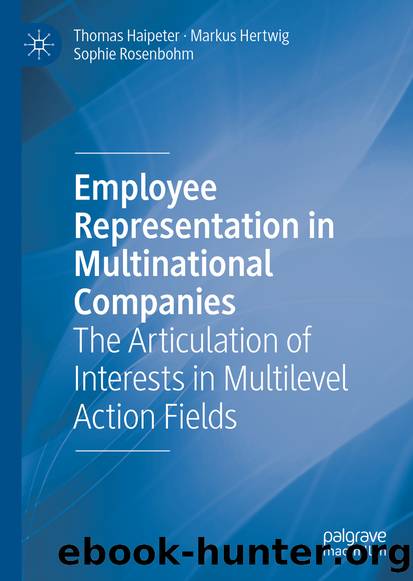Employee Representation in Multinational Companies by Thomas Haipeter & Markus Hertwig & Sophie Rosenbohm

Author:Thomas Haipeter & Markus Hertwig & Sophie Rosenbohm
Language: eng
Format: epub
ISBN: 9783319975597
Publisher: Springer International Publishing
Interest Articulation During Restructuring
âRubberâ
The three companies in this category, the practice of articulation by employee representatives at âRubberâ corresponded most closely with the pattern of âinternational integrationâ. The core activity for employee representatives during restructuring consisted of exchanging information at both transnational and national level. By contrast, articulation effectively ceased when it came to inter-plant competition. Not only was there no exchange of information but on occasions information was held back, hampering the forming of common interests.
The most recent restructuring plans at âRubberâ generated a rather restrained reaction from employee representatives. Although the EWC expressed its concern, including the issuing of a joint opinion criticising managementâs closure plans and holding their poor decision-making responsible for the companyâs difficulties, there were no joint activities by local and national workforce representatives and the EWC. And despite the fact that the companyâs strategy was transnational in natureâas expressly designated by managementâtransnational employee representatives restricted their activity to ensuring that the closures were undertaken in a socially responsible way in the countries affected (mainly France, Northern Ireland, and Hungary). Substantive negotiations on the closures were concluded exclusively at local level and without the EWCâs involvement.
Interest representation during this restructuring was characterised by weak coordination, a strict division of labour between the levels of employee representation, and only a loose coupling between the various representative bodies. This affected, firstly, coordination across levels. The EWC, national bodies, and local negotiators in Hungary and Northern Ireland were only linked via the exchange of very basic information. This was largely confined to passing on information at regular EWC meetings, where âthe state of negotiations on Northern Ireland and Hungaryâ was a customary agenda item (Rubber-DE-1). The added value derived from coordination between the transnational level (EWC) and national level (trade union negotiators in the UK) consisted in the forwarding of significant information. For instance, information provided by the EWC was used in Northern Ireland to improve the local negotiating position, as British employee representatives were then able to gauge the type of redundancy package they might reasonably expect to negotiate, with details about what had been agreed at other plants serving as a benchmark to put pressure on the company. This also prevented representatives from being played off against each other, as it was possible to point to and demand concessions offered by the company at other sites (e.g. on severance payments or the scope for company-financed training).
One of the preconditions for the ability of the EWC at âRubberâ to play such a supportive role was the existence of a functioning relationship between the EWC and management, who complied with the information and consultation procedure stipulated for restructuring proposals. Overall, management was seen as a fair counterparty by those involved. Information was always made available openly and at the appropriate time, and the chosen strategy was adhered to consistently.
Although integration (horizontally ) appeared to be strong during the restructuring at âRubberâ, it also had ambivalent aspects. Exchanges within the EWC (and between some individual EWC actors) were dense and based on trust.
Download
This site does not store any files on its server. We only index and link to content provided by other sites. Please contact the content providers to delete copyright contents if any and email us, we'll remove relevant links or contents immediately.
Time Management Made Easy: How to Cultivate New Habits, Improve Productivity and Get Things Done by Joshua Strachan(2365)
The 7 Habits of Highly Effective People by Stephen R. Covey & Sean Covey(2098)
The Concise Laws of Human Nature by Robert Greene(1712)
Doesn't Hurt to Ask by Trey Gowdy(1555)
Primal Leadership by Daniel Goleman(1125)
Hook Point: How to Stand Out in a 3-Second World by Brendan Kane(1098)
HBR's 10 Must Reads 2021 by unknow(1044)
Don't Sweat the Small Stuff...and It's All Small Stuff by Richard Carlson(1012)
Amazon Unbound by Brad Stone(979)
100 Things Successful People Do by Nigel Cumberland(963)
HBR's 10 Must Reads 2021 by Harvard Business Review(955)
The Job Closer by Steve Dalton(937)
Master of One by Jordan Raynor(934)
Lives of the Stoics by Ryan Holiday & Stephen Hanselman(899)
Declutter Your Mind: A step by step guide to learn to control your thoughts, stop worrying, relieve anxiety and eliminate panic attacks and negative thinking by Mia Chandler(875)
The Power of 100! by Shaun King(843)
Conflicted by Ian Leslie(798)
Coders at Work: Reflections on the craft of programming by Peter Seibel(787)
The Book of Hope by Jane Goodall(743)
